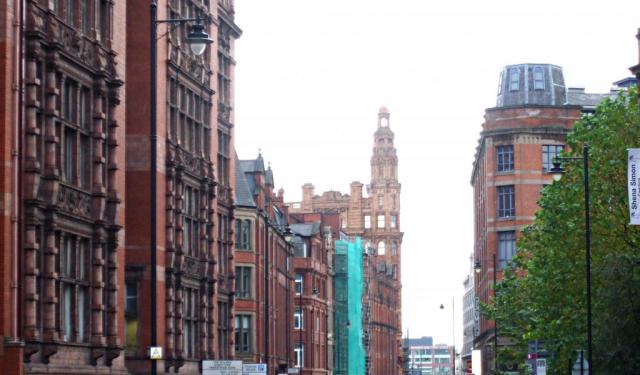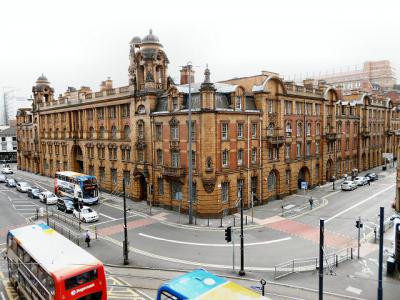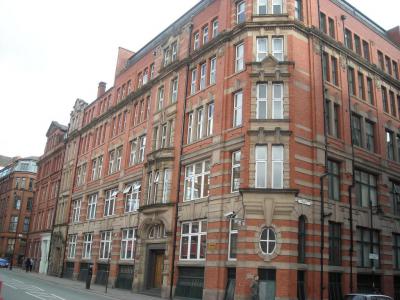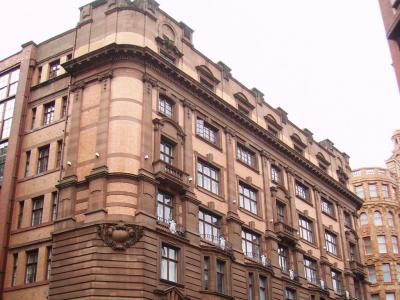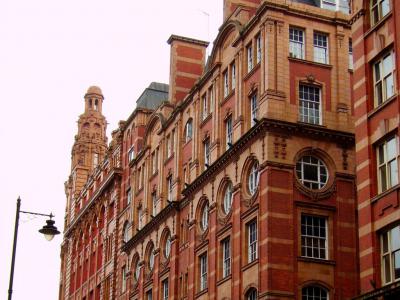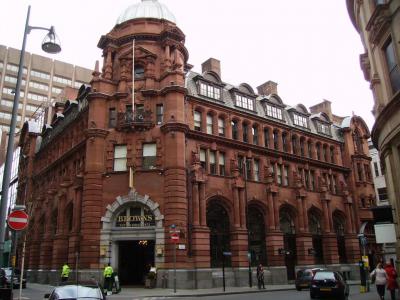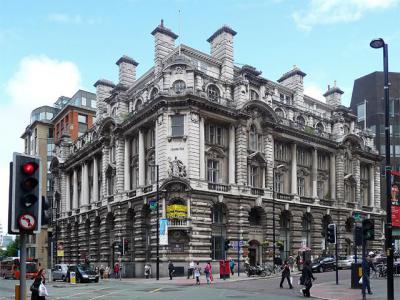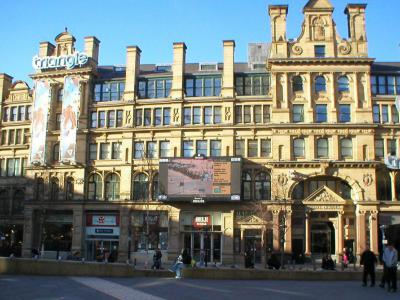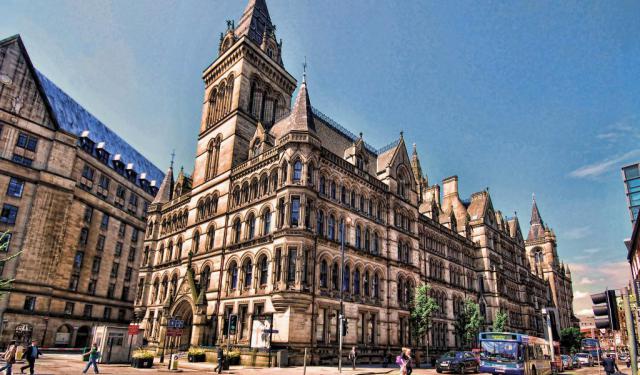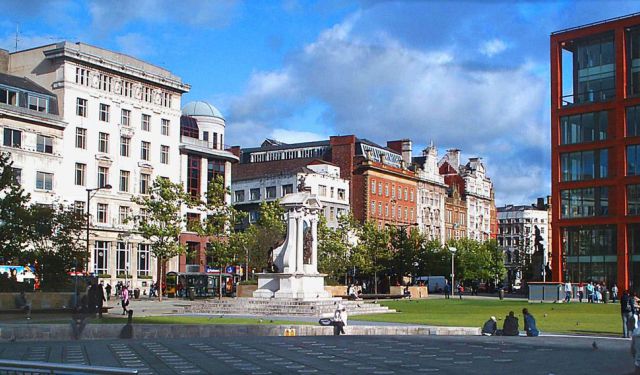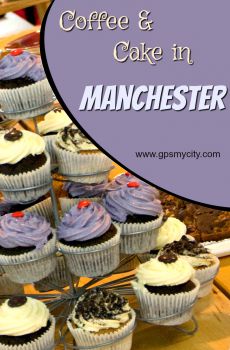Edwardian Architecture Tour (Self Guided), Manchester
A product of the Industrial Revolution, Manchester is noted for its warehouses, railway viaducts, cotton mills, and canals, reflecting the most ambitious and exciting phase of the city's history.
During the reign of King Edward VII, which spanned from 1901 to 1910, Manchester experienced a significant boom in architectural development. This period saw a shift towards more ornate and intricate designs, departing from the simpler styles of the Victorian era that preceded it, ultimately giving rise to the so-called Edwardian architecture much popular in the United Kingdom at the turn of the 20th century. Several iconic buildings in Manchester exemplify this style.
The London Road Fire Station is a notable example, featuring an imposing terracotta-brick façade adorned with complex stone detailing. Originally constructed as a fire station, it now stands as a symbol of Manchester's architectural grandeur.
Whitworth Street boasts Asia House, which showcases a fusion of Edwardian and Oriental elements, characterized by its distinctive brown-brick construction and decorative details. Similarly, Lancaster House, India House, and Canada House all demonstrate the Edwardian penchant for blending traditional and exotic influences into their structure.
The Former National Westminster Bank and Lloyds Bank, located in the heart of the city, reflect the financial prosperity of the era with their opulent facades and elaborate interiors.
The Triangle is another iconic Edwardian construction, known for its triangular shape and elegant design. Originally the corn exchange, this building has evolved into a bustling shopping and entertainment center while preserving its historic charm.
Collectively, these architectural gems are a testament to the creativity and craftsmanship of the Edwardian architects who shaped Manchester's skyline a century ago. To distinguish Edwardian architecture from the vast array of other styles present in Manchester and discover yet another beautiful side of the city, we invite you to take this self-guided walk!
During the reign of King Edward VII, which spanned from 1901 to 1910, Manchester experienced a significant boom in architectural development. This period saw a shift towards more ornate and intricate designs, departing from the simpler styles of the Victorian era that preceded it, ultimately giving rise to the so-called Edwardian architecture much popular in the United Kingdom at the turn of the 20th century. Several iconic buildings in Manchester exemplify this style.
The London Road Fire Station is a notable example, featuring an imposing terracotta-brick façade adorned with complex stone detailing. Originally constructed as a fire station, it now stands as a symbol of Manchester's architectural grandeur.
Whitworth Street boasts Asia House, which showcases a fusion of Edwardian and Oriental elements, characterized by its distinctive brown-brick construction and decorative details. Similarly, Lancaster House, India House, and Canada House all demonstrate the Edwardian penchant for blending traditional and exotic influences into their structure.
The Former National Westminster Bank and Lloyds Bank, located in the heart of the city, reflect the financial prosperity of the era with their opulent facades and elaborate interiors.
The Triangle is another iconic Edwardian construction, known for its triangular shape and elegant design. Originally the corn exchange, this building has evolved into a bustling shopping and entertainment center while preserving its historic charm.
Collectively, these architectural gems are a testament to the creativity and craftsmanship of the Edwardian architects who shaped Manchester's skyline a century ago. To distinguish Edwardian architecture from the vast array of other styles present in Manchester and discover yet another beautiful side of the city, we invite you to take this self-guided walk!
How it works: Download the app "GPSmyCity: Walks in 1K+ Cities" from Apple App Store or Google Play Store to your mobile phone or tablet. The app turns your mobile device into a personal tour guide and its built-in GPS navigation functions guide you from one tour stop to next. The app works offline, so no data plan is needed when traveling abroad.
Edwardian Architecture Tour Map
Guide Name: Edwardian Architecture Tour
Guide Location: England » Manchester (See other walking tours in Manchester)
Guide Type: Self-guided Walking Tour (Sightseeing)
# of Attractions: 9
Tour Duration: 2 Hour(s)
Travel Distance: 2.6 Km or 1.6 Miles
Author: alexander
Sight(s) Featured in This Guide:
Guide Location: England » Manchester (See other walking tours in Manchester)
Guide Type: Self-guided Walking Tour (Sightseeing)
# of Attractions: 9
Tour Duration: 2 Hour(s)
Travel Distance: 2.6 Km or 1.6 Miles
Author: alexander
Sight(s) Featured in This Guide:
- London Road Fire Station
- Whitworth Street
- Asia House
- Lancaster House
- India House
- Canada House
- Former National Westminster Bank
- Lloyds Bank
- The Triangle
1) London Road Fire Station
London Road Fire Station in Manchester is a notable example of Edwardian Baroque architecture. Designed by Woodhouse, Willoughby, and Langham, the fire station opened in 1906 and features red brick and terracotta construction. The building complex, situated at a prime location bordered by London Road, Whitworth Street, Minshull Street South, and Fairfield Street, has been a Grade II* listed building since 1974.
Originally built by J. Gerrard and Sons of Swinton, London Road Fire Station was more than just a fire station; it included a police station, an ambulance station, a bank, a coroner's court, and a gas-meter testing station. The station served as a comprehensive civic facility housing not only firemen and their families but also providing essential services to the community. Initially equipped with horse-drawn fire appliances, the station transitioned to motorized vehicles shortly after its opening.
During its operational years, the fire station was significant in the community, especially during World War II when it was visited by royalty in 1942 to honor the brigade's efforts. Post-war, it evolved into a training center and became notable in 1952 as the first center equipped to record emergency calls. The building also served as the headquarters for the Manchester Fire Brigade until 1974, after which the Greater Manchester Fire Service took over, leading to its eventual closure in 1986.
After closing, the building fell into a period of decline and was largely unused, prompting its placement on English Heritage's Buildings at Risk Register in 2001. A significant turning point came in 2010 when Manchester City Council issued a compulsory purchase order to Britannia Hotels, which had left the building derelict for nearly 30 years. The building was finally sold to Allied London in 2015, and in 2018, redevelopment work began to transform the site into a mixed-use facility focusing on leisure and hotel amenities, aiming to restore its historic grandeur and utility.
Originally built by J. Gerrard and Sons of Swinton, London Road Fire Station was more than just a fire station; it included a police station, an ambulance station, a bank, a coroner's court, and a gas-meter testing station. The station served as a comprehensive civic facility housing not only firemen and their families but also providing essential services to the community. Initially equipped with horse-drawn fire appliances, the station transitioned to motorized vehicles shortly after its opening.
During its operational years, the fire station was significant in the community, especially during World War II when it was visited by royalty in 1942 to honor the brigade's efforts. Post-war, it evolved into a training center and became notable in 1952 as the first center equipped to record emergency calls. The building also served as the headquarters for the Manchester Fire Brigade until 1974, after which the Greater Manchester Fire Service took over, leading to its eventual closure in 1986.
After closing, the building fell into a period of decline and was largely unused, prompting its placement on English Heritage's Buildings at Risk Register in 2001. A significant turning point came in 2010 when Manchester City Council issued a compulsory purchase order to Britannia Hotels, which had left the building derelict for nearly 30 years. The building was finally sold to Allied London in 2015, and in 2018, redevelopment work began to transform the site into a mixed-use facility focusing on leisure and hotel amenities, aiming to restore its historic grandeur and utility.
2) Whitworth Street
Running for a mile from east to west between Manchester’s Piccadilly and Deansgate stations, Whitworth Street is one of Manchester city centre’s most historic streets. The long lane runs alongside a rail viaduct, cutting through the southern side of the city centre – becoming Whitworth Street West for the western half of its diameter. The street is named after local manufacturer and philanthropist Sir Joseph Whitworth, creator of the Whitworth rifle. His works building once stood on Whitworth Street, part of the Edwardian industrial heritage Manchester is known for, and which can best be seen along this avenue.
Whitworth Street is characterised by the grand, well preserved Edwardian warehouses which line its length. The area developed after the opening of Manchester’s Ship Canal in 1894, which opened the city up to international maritime trade. Many buildings constructed in the early 20th century still remain, including Manchester University’s Sackville Street building and India House, both of which are Grade II listed buildings. The street also has links to Manchester’s recent history, with the former Hacienda nightclub situated in the middle of the street, and the still active Ritz nightclub located on Whitworth Street West. Both venues helped make Manchester arguably the musical capital of the UK in the late 20th century.
Whitworth Street is characterised by the grand, well preserved Edwardian warehouses which line its length. The area developed after the opening of Manchester’s Ship Canal in 1894, which opened the city up to international maritime trade. Many buildings constructed in the early 20th century still remain, including Manchester University’s Sackville Street building and India House, both of which are Grade II listed buildings. The street also has links to Manchester’s recent history, with the former Hacienda nightclub situated in the middle of the street, and the still active Ritz nightclub located on Whitworth Street West. Both venues helped make Manchester arguably the musical capital of the UK in the late 20th century.
3) Asia House
Asia House on Princess Street in Manchester stands as a notable historical building from the early 20th century. Constructed between 1906 and 1909, it exemplifies Edwardian Baroque architecture and has been recognized as a Grade II* listed building since October 3, 1974. Originally a packing and shipping warehouse designed for the Refuge Assurance Company, it served multiple shipping merchants, such as the Oxford Packing Company, and housed 36 shipping merchants by 1910.
The building was designed by I.R.E. Birkett, according to architectural historian Nikolaus Pevsner in his book The Buildings of England. However, English Heritage attributes the design to Harry S. Fairhurst. Asia House is particularly noted for its lavish interiors, including an "exceptionally rich" entrance hall and stairwell adorned with veined marble, green and cream faience, Art Nouveau stained glass, and tree motifs.
The structure of Asia House is built on a trapezoidal plan and consists of two linked blocks, each rising six stories high plus an attic above a double basement. Its facade is constructed with pink-brown sandstone, brick, and marble. The side and rear elevations feature glazed white brick and common brick, respectively. Originally, the warehouse had loading bays situated between the blocks, connected to packing rooms in the basement via shafts. These areas facilitated the movement of goods, which were then dispatched after being packed into bales using hydraulic presses powered by Manchester's hydraulic power system. The building was illuminated by gas.
Reflecting changes in urban utilization, Asia House was converted into residential units in 2003, with its basement repurposed as a car park. It has been home to notable residents, including Noel Gallagher, the famed singer-songwriter from the band Oasis. Asia House remains a prime example of Manchester's rich industrial heritage and its adaptation to modern urban living.
The building was designed by I.R.E. Birkett, according to architectural historian Nikolaus Pevsner in his book The Buildings of England. However, English Heritage attributes the design to Harry S. Fairhurst. Asia House is particularly noted for its lavish interiors, including an "exceptionally rich" entrance hall and stairwell adorned with veined marble, green and cream faience, Art Nouveau stained glass, and tree motifs.
The structure of Asia House is built on a trapezoidal plan and consists of two linked blocks, each rising six stories high plus an attic above a double basement. Its facade is constructed with pink-brown sandstone, brick, and marble. The side and rear elevations feature glazed white brick and common brick, respectively. Originally, the warehouse had loading bays situated between the blocks, connected to packing rooms in the basement via shafts. These areas facilitated the movement of goods, which were then dispatched after being packed into bales using hydraulic presses powered by Manchester's hydraulic power system. The building was illuminated by gas.
Reflecting changes in urban utilization, Asia House was converted into residential units in 2003, with its basement repurposed as a car park. It has been home to notable residents, including Noel Gallagher, the famed singer-songwriter from the band Oasis. Asia House remains a prime example of Manchester's rich industrial heritage and its adaptation to modern urban living.
4) Lancaster House
Lancaster House, located on Whitworth Street in Manchester, is a historic building originally constructed as a packing and shipping warehouse between 1905 and 1910. It was built for Lloyd's Packing Warehouses Limited, which had become the leading commercial packing firm in Manchester following a series of mergers. Designed by Harry S. Fairhurst, a prominent architect known for his expertise in warehouse design, Lancaster House exemplifies the Edwardian Baroque style. The structure features a steel frame, with the lower portions clad in granite and the upper portions in Accrington red brick and orange terracotta, while the rear is made of plain red brick.
As of October 2, 1974, Lancaster House is recognized as a Grade II* listed building, highlighting its architectural and historical significance. Fairhurst's design is noted for its high-quality, fireproof specifications. Lancaster House is not just architecturally tied to its era but also physically connected to its neighboring building, India House, through an ornate, Art Nouveau wrought iron gate featuring a pendant lamp.
The building has undergone significant transformations over the years; it has been converted into residential flats and is now split into two sections. These are located on Whitworth Street and Princess Street, respectively. The conversion includes facilities such as O'Sheas Irish Bar, which is accessible via the corner entrance.
Additionally, Lancaster House is part of a broader conservation area established by Manchester City Council in September 1974 and expanded in June 1985. This area was designated to preserve the historical context of Manchester's textile industry, reflecting the city's rich industrial past. The conservation area includes significant streets and landmarks, underscoring the ongoing effort to maintain the architectural and historical fabric of Manchester city center.
As of October 2, 1974, Lancaster House is recognized as a Grade II* listed building, highlighting its architectural and historical significance. Fairhurst's design is noted for its high-quality, fireproof specifications. Lancaster House is not just architecturally tied to its era but also physically connected to its neighboring building, India House, through an ornate, Art Nouveau wrought iron gate featuring a pendant lamp.
The building has undergone significant transformations over the years; it has been converted into residential flats and is now split into two sections. These are located on Whitworth Street and Princess Street, respectively. The conversion includes facilities such as O'Sheas Irish Bar, which is accessible via the corner entrance.
Additionally, Lancaster House is part of a broader conservation area established by Manchester City Council in September 1974 and expanded in June 1985. This area was designated to preserve the historical context of Manchester's textile industry, reflecting the city's rich industrial past. The conservation area includes significant streets and landmarks, underscoring the ongoing effort to maintain the architectural and historical fabric of Manchester city center.
5) India House
India House in Manchester is a historically significant building located on Whitworth Street. Constructed in 1906, it originally served as a packing and shipping warehouse for Lloyd's Packing Warehouses Limited, which, after a series of mergers, emerged as a dominant force in Manchester’s commercial packing sector in the early 20th century. The structure is designed in the Edwardian Baroque style, characterized by its steel frame and an elegant cladding of buff terracotta and red brick, complemented by buff terracotta dressings.
Designed by Harry S. Fairhurst, India House showcases his architectural prowess, also evident in nearby structures such as Bridgewater House and Lancaster House. Fairhurst’s designs are notable for their robust, steel-framed construction and high-quality fireproof specifications, ensuring durability and safety.
The layout of India House was meticulously planned to support its logistic functions. The building features a raised ground floor with a showroom and offices designed to impress clients, while the first floor houses additional offices and spaces like waiting rooms, and sample and pattern rooms. The upper floors, used for actual packing operations, were more utilitarian with large windows to maximize natural lighting. India House is also notable for its cultural significance, having been the residence of Noel Gallagher in the 1990s, where he wrote the hit song "Live Forever."
The building has been recognized as a Grade II* listed building since October 2, 1974, underscoring its architectural and historical importance. It is part of a conservation area designated by Manchester City Council in September 1974, which was established to preserve the area reflecting the rich history of the textile industry in the city center. This conservation area, initially bounded by several major streets and the Piccadilly to Oxford Road railway viaduct was later expanded in June 1985. The designation of India House and its surrounding area highlights Manchester’s commitment to preserving its industrial heritage while celebrating its cultural history.
Designed by Harry S. Fairhurst, India House showcases his architectural prowess, also evident in nearby structures such as Bridgewater House and Lancaster House. Fairhurst’s designs are notable for their robust, steel-framed construction and high-quality fireproof specifications, ensuring durability and safety.
The layout of India House was meticulously planned to support its logistic functions. The building features a raised ground floor with a showroom and offices designed to impress clients, while the first floor houses additional offices and spaces like waiting rooms, and sample and pattern rooms. The upper floors, used for actual packing operations, were more utilitarian with large windows to maximize natural lighting. India House is also notable for its cultural significance, having been the residence of Noel Gallagher in the 1990s, where he wrote the hit song "Live Forever."
The building has been recognized as a Grade II* listed building since October 2, 1974, underscoring its architectural and historical importance. It is part of a conservation area designated by Manchester City Council in September 1974, which was established to preserve the area reflecting the rich history of the textile industry in the city center. This conservation area, initially bounded by several major streets and the Piccadilly to Oxford Road railway viaduct was later expanded in June 1985. The designation of India House and its surrounding area highlights Manchester’s commitment to preserving its industrial heritage while celebrating its cultural history.
6) Canada House
Canada House is a significant historical and architectural landmark in Manchester. Constructed in 1908-09 by W.G. Higginbottom, it was initially built for J.S. Booth and Company, a prominent textile firm, as part of a cluster of buildings known as Princes Buildings (A, B, C, and D). The building is situated on Chepstow Street and is recognized as a Grade II listed structure, highlighting its importance in architectural and cultural heritage.
Historically, the area where Canada House stands was undeveloped fields until the early 19th century. The construction of the nearby Rochdale Canal in 1804 catalyzed urban expansion towards this part of Manchester, transforming it into an industrial quarter specializing in iron, glass, and marble works. This development also included slum dwellings for workers and other warehouses, among them Canada House.
Architecturally, Canada House is designed in the Art Nouveau style, retaining many of its original features which contribute to its distinct character. The building comprises six floors and a basement, designed for multifunctional use. The western side of the building features elaborate and flexible office spaces, while the eastern side, facing a canal spur, was originally used for cloth processing.
In recent years, Canada House has been refurbished by Kinrise, who transformed it into a modern office space while respecting its architectural heritage. The building now hosts 24 resident businesses, including several in the digital and creative industries, and operates at full capacity. It has been equipped with new amenities such as the Clink Café, screening and meeting rooms, and co-working spaces.
Strategically located near important cultural and educational institutions like the Central Library and Archive, Greater Manchester Central Convention Centre, Manchester University, and Manchester Metropolitan University, Canada House remains a vibrant part of Manchester’s cultural and entertainment district. Its proximity to significant venues like the Palace Theatre, Bridgewater Hall, Manchester HOME, and Manchester Art Gallery, along with numerous historic pubs, underscores its standing as a central and lively spot in the city.
Historically, the area where Canada House stands was undeveloped fields until the early 19th century. The construction of the nearby Rochdale Canal in 1804 catalyzed urban expansion towards this part of Manchester, transforming it into an industrial quarter specializing in iron, glass, and marble works. This development also included slum dwellings for workers and other warehouses, among them Canada House.
Architecturally, Canada House is designed in the Art Nouveau style, retaining many of its original features which contribute to its distinct character. The building comprises six floors and a basement, designed for multifunctional use. The western side of the building features elaborate and flexible office spaces, while the eastern side, facing a canal spur, was originally used for cloth processing.
In recent years, Canada House has been refurbished by Kinrise, who transformed it into a modern office space while respecting its architectural heritage. The building now hosts 24 resident businesses, including several in the digital and creative industries, and operates at full capacity. It has been equipped with new amenities such as the Clink Café, screening and meeting rooms, and co-working spaces.
Strategically located near important cultural and educational institutions like the Central Library and Archive, Greater Manchester Central Convention Centre, Manchester University, and Manchester Metropolitan University, Canada House remains a vibrant part of Manchester’s cultural and entertainment district. Its proximity to significant venues like the Palace Theatre, Bridgewater Hall, Manchester HOME, and Manchester Art Gallery, along with numerous historic pubs, underscores its standing as a central and lively spot in the city.
7) Former National Westminster Bank
The former National Westminster Bank building in Spring Gardens, Manchester, stands as a prominent example of Edwardian architectural elegance. Constructed in 1902, originally for Parr's Bank, this structure was designed by Charles Heathcote. It reflects a bold Edwardian Baroque style and has been recognized for its architectural significance as a Grade II* listed building since January 4, 1972.
The building's exterior is crafted from red sandstone and is distinguished by a corner tower topped with a cupola. It features Doric columns that support ornamental brackets rather than structural elements and hooded gables that add to its grandeur. One of the most striking features of the bank is its vast plate glass windows, designed to flood the banking hall with light. These windows include large round-headed panes filling the width of each bay, with molded heads, scrolled keystones, and plate-glass glazing adorned with enriched bronze 'ferramenta'. The design incorporates a horizontal mid-panel, bottom panels with stained glass, and arched upper lights with margin panes.
Internally, the bank's foyer is richly decorated with mahogany paneling, and the main banking hall is lined with walls of green marble, making it one of the most opulent interiors of its time not only in Manchester but also comparable to those in London. The original stained glass and intricate Art Nouveau ironwork on the exterior further enhance its aesthetic and historical value.
As of February 2024, this historical building has taken on a new life as a Browns brasserie and bar, continuing its legacy while serving a modern function in the heart of Manchester.
The building's exterior is crafted from red sandstone and is distinguished by a corner tower topped with a cupola. It features Doric columns that support ornamental brackets rather than structural elements and hooded gables that add to its grandeur. One of the most striking features of the bank is its vast plate glass windows, designed to flood the banking hall with light. These windows include large round-headed panes filling the width of each bay, with molded heads, scrolled keystones, and plate-glass glazing adorned with enriched bronze 'ferramenta'. The design incorporates a horizontal mid-panel, bottom panels with stained glass, and arched upper lights with margin panes.
Internally, the bank's foyer is richly decorated with mahogany paneling, and the main banking hall is lined with walls of green marble, making it one of the most opulent interiors of its time not only in Manchester but also comparable to those in London. The original stained glass and intricate Art Nouveau ironwork on the exterior further enhance its aesthetic and historical value.
As of February 2024, this historical building has taken on a new life as a Browns brasserie and bar, continuing its legacy while serving a modern function in the heart of Manchester.
8) Lloyds Bank
The former Lloyds Bank building in Manchester is a notable architectural landmark situated at the intersection of King Street and Cross Street. Constructed in 1915, the building was designed by Charles Heathcote, a prominent architect known for his work in the early 20th century. This building exemplifies an elaborate Baroque style and is structured on an L-shaped plot, featuring seven bays along King Street and eight bays on Cross Street, with a chamfered corner uniting the two facades.
The building is made from Portland stone set on a granite plinth and includes a basement, four main stories, and double attics, highlighting its grand design and imposing presence. Noteworthy for its ornate detailing, the structure boasts carvings and statuary crafted by the artistic team of Earp, Hobbs, and Miller, which add to its historic and aesthetic value.
In 1974, the building received Grade II listed status, recognizing its architectural and historical importance, particularly as it stands on the site of the old Manchester Town Hall. Although it formerly housed a branch of Lloyds Bank, the building's function has evolved over the years. As of 2023, it hosts L'Antica, a pizzeria. Previously, it served as a location for Zizzi, a chain of Italian food restaurants, marking its transition from a banking institution to a culinary destination in Manchester’s urban landscape.
The building is made from Portland stone set on a granite plinth and includes a basement, four main stories, and double attics, highlighting its grand design and imposing presence. Noteworthy for its ornate detailing, the structure boasts carvings and statuary crafted by the artistic team of Earp, Hobbs, and Miller, which add to its historic and aesthetic value.
In 1974, the building received Grade II listed status, recognizing its architectural and historical importance, particularly as it stands on the site of the old Manchester Town Hall. Although it formerly housed a branch of Lloyds Bank, the building's function has evolved over the years. As of 2023, it hosts L'Antica, a pizzeria. Previously, it served as a location for Zizzi, a chain of Italian food restaurants, marking its transition from a banking institution to a culinary destination in Manchester’s urban landscape.
9) The Triangle
The Triangle Shopping Centre is housed in an Edwardian building on Exchange Square, in Manchester’s regenerated Millennium Quarter. There has been a commercial centre standing on this spot since 1837, when the first trading floor opened. The triangular building that contains the shopping centre was built in 1897, and opened its doors as a Corn Exchange in 1903. Like the nearby Royal Exchange, the building was a thriving centre for the trading of goods in Depression era England, and contributed to Manchester’s growth as the industrial and commercial centre of the region. After World War 2, the building fell into disuse, before becoming a bohemian flea market in the 1970s.
The building became well known for its alternative stores selling clothes and jewellery, as well as a range of cafes. Bomb damage from the IRA blast in 1996 led to extensive regeneration, and caused a great number of these shops and stalls to be relocated. Now refitted with a modern interior inside the listed Edwardian frontage, the building is home to a number of designer outlets. Famous brands like Adidas, Muji, O’Neill and Jigsaw have stores within the centre, and it is also home to local radio station Galaxy Manchester.
The building became well known for its alternative stores selling clothes and jewellery, as well as a range of cafes. Bomb damage from the IRA blast in 1996 led to extensive regeneration, and caused a great number of these shops and stalls to be relocated. Now refitted with a modern interior inside the listed Edwardian frontage, the building is home to a number of designer outlets. Famous brands like Adidas, Muji, O’Neill and Jigsaw have stores within the centre, and it is also home to local radio station Galaxy Manchester.
Walking Tours in Manchester, England
Create Your Own Walk in Manchester
Creating your own self-guided walk in Manchester is easy and fun. Choose the city attractions that you want to see and a walk route map will be created just for you. You can even set your hotel as the start point of the walk.
Manchester Historical Architecture Tour
Manchester’s architecture is rich in styles. Throughout centuries, the city has evolved in phases, each of which left its peculiar imprint on the city's architectural tapestry. Here, you can see medieval red-brick buildings coexisting harmoniously with concrete-and-glass structures from the modern era.
One notable landmark in Manchester is the Statue of Prince Albert, a regal monument... view more
Tour Duration: 1 Hour(s)
Travel Distance: 1.6 Km or 1 Miles
One notable landmark in Manchester is the Statue of Prince Albert, a regal monument... view more
Tour Duration: 1 Hour(s)
Travel Distance: 1.6 Km or 1 Miles
Manchester Introduction Walking Tour
The seventh most populated city in England, Manchester is an important cultural, industrial and historic center.
The recorded history of Manchester began with the civilian settlement associated with the Roman fort established circa 79 AD on a sandstone bluff near the confluence of the rivers Medlock and Irwell. Having been a manorial township throughout the Middle Ages, Manchester enjoyed rapid... view more
Tour Duration: 2 Hour(s)
Travel Distance: 2.5 Km or 1.6 Miles
The recorded history of Manchester began with the civilian settlement associated with the Roman fort established circa 79 AD on a sandstone bluff near the confluence of the rivers Medlock and Irwell. Having been a manorial township throughout the Middle Ages, Manchester enjoyed rapid... view more
Tour Duration: 2 Hour(s)
Travel Distance: 2.5 Km or 1.6 Miles
Useful Travel Guides for Planning Your Trip
Top 8 Cafes and Sweet Shops in Manchester
Heading up Oldham Street from Picadilly Gardens you arrive at The Northern Quarter; the ‘cool’ part of Manchester, think Brooklyn, Shoreditch, Le Marais; trendy young things with fancy haircuts frequent the coffee houses, boutique and vintage shops during the day and the bars once night-time...
The Most Popular Cities
/ view all
